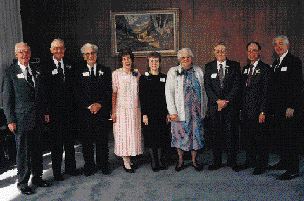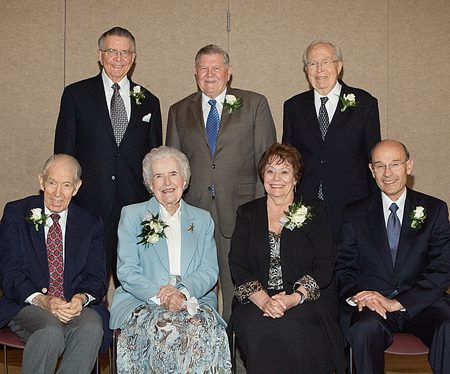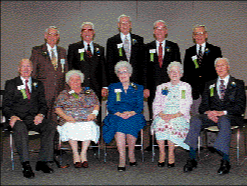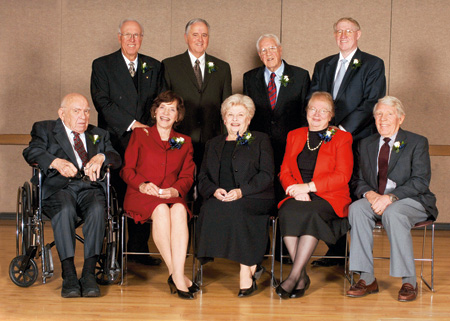 One of the highlights of the Emeritus Association is the group’s presentation of Special Recognition Awards each year. The distinction was given to nine men and women at the association’s annual meeting on March 15, 1997.
One of the highlights of the Emeritus Association is the group’s presentation of Special Recognition Awards each year. The distinction was given to nine men and women at the association’s annual meeting on March 15, 1997.
Carl D. Clark, outgoing president of the 20,000-member association, inducted the Class of 1957 into the group. BYU President Merrill J. Bateman addressed the audience, comprising retired faculty, administrators, and alumni who attended BYU at least 40 years ago.
Honored with awards were Harold J. Anderson, Francis E. Broadbent, Isabel Hales Cannon, Ruth Call Evans, Paul E. Felt, E. William Jackson, Marcene Camp Jardine, James K. Seastrand, and Robert W. Stum.
Anderson retired as director of BYU’s Physical Plant in 1986 after serving 30 years in the department. The 1948 BYU graduate was hired in 1956 by the university’s Campus Planning and Development Department, which later was consolidated with the Department of Physical Plant. The department was responsible to the university president and the Church commissioner of education for planning, construction, and operations at BYU, Ricks College, BYU–Hawaii, and other Church schools. Anderson served as assistant director to Sam F. Brewster before becoming director in 1979.
Broadbent is best known for his teaching and research in soil science. At an early date he recognized environmental problems with fertilizer nitrogen use as well as with pesticides and found solutions that would benefit the agricultural community. A major contributor to knowledge of organic matter in soils, he was among the first to write the now-extensive literature on tracer nitrogen in soil-plant systems. Broadbent taught at the University of California, Riverside, and at Cornell University before joining the faculty at the University of California, Davis, where he taught for 33 years.
Cannon, as the supportive wife of a General Authority, caring mother of seven children, and a dedicated Church worker, exemplifies intelligence put to work in the service of others. Valedictorian of her class at BYU, she taught at Provo High School and the University of Utah. Cannon supervised the Relief Society, Young Women, and Primary in the area when her husband, George, presided over the Central British Mission. She later served as an area general board representative when he was a member of the presidency of the Asia and Philippines/Micronesia Area.
Evans, who was valedictorian at Juarez Stake Academy in the Mormon colonies in Chihuahua, Mexico, completed bachelor’s and master’s degrees and served a mission in Mexico and Central America. Teaching school early in her marriage, she championed community/parent involvement in education while rearing her children. On the board of education of the Orange Unified School District for 20 years, Evans was a representative to the Governor’s State House Conference on Children and Youth twice. The programs she initiated in the district include consumer education for Mexican- American women.
Felt was nearly 80 years old when he retired from BYU’s religious education faculty in 1994. BYU student body president 194142, he taught seminary and institute classes after serving in the navy, inaugurating the first LDS institute outside the U.S. and the first single adults ward in the Church. Felt returned to BYU as coordinator of student affairs and soon joined the religion faculty. He also served as the first director of the Office of Indian Affairs. In 1971 he left BYU temporarily to serve as mission president of the Southwest Indian Arizona/New Mexico Mission.
Jackson, when he was called as president of the Philippines Manila Mission in 1986, began an additional mission: providing free corrective surgery to young patients suffering from congenital health problems. Inspired by the dramatic changes that surgery produced in the lives of the children, he mobilized dozens of LDS physicians and dentists to travel to foreign countries to give humanitarian care. With the help of private donations and volunteer services, Jackson founded Deseret Foundation International, which now treats more than 5,000 surgical and 1,000 dental cases annually in disadvantaged nations throughout the world.
Jardine was twice named outstanding vocalist while studying music at BYU. She first met her husband, Earl, in a conducting class, then again when he played in the orchestra while she sang the lead in I Pagliacci. Soprano soloist in numerous concerts, she started a tradition of “Messiah Sings” in Church stakes in California and is the only woman to have conducted the Ventura Symphony in a performance of the oratorio. Jardine worked 21 years as a traveling music teacher in Oxnard School District and 15 years teaching voice production and choir at Oxnard College.
Seastrand, a 1954 graduate of BYU with a degree in marketing and business administration, spent most of his career in retail management and was president of Vegas Village Shopping Corp. For the past 16 years, he has served as mayor of North Las Vegas and in 1990 was named Nevada Public Official of the Year. His community service includes being chair of the Lake Mead Hospital Board. Chair of the Las Vegas Temple building committee, he was a stake president for 10 years and a Regional Representative for seven years.
Stum, an expert in photography and cinematography, joined BYU’s Motion Picture Studio shortly after it was established in 1953. He had taken art classes at BYU and attended the Art Center School in Los Angeles, where he was tutored by professional cinematographers in Hollywood. During his 28 years with BYU’s studio, he filmed 140 productions, including such Church classics as Man’s Search for Happiness, Windows of Heaven, Ancient America Speaks, and Johnny Lingo.Stum received the National Award for Meritorious Contributions from the Professional Photographers of America.









